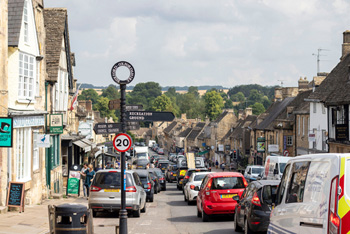Councillors in Oxfordshire have backed plans for widespread 20mph limits as part of an ‘ambitious and innovative’ new transport plan that aims to create a ‘healthier, better digitally connected, more active’ county.
Oxfordshire CC said its Local Transport and Connectivity Plan sets out to achieve this by reducing the need to travel and discouraging unnecessary individual private vehicle use through making walking, cycling, public and shared transport ‘the natural first choice’.

Burford in Oxfordshire
The plan also includes the concept of the 20-minute neighbourhood, where goods and services are within a 20-minute walk. Cabinet members approved the plan on Tuesday (19 October) subject to consultation next month.
Tim Bearder, cabinet member for highways management, said: ‘We have a vision to transform transport in Oxfordshire. We want to be less reliant on the car and all enjoy access to vastly improved public transport and gold standard walking and cycling paths.
‘We know we face a climate emergency and the least well off are being left behind. Our current network incentivises more carbon waste and is overly focused on expensive single occupancy cars.
‘We are miles away from where we should be so this plan represents an exciting milestone in the development of a transport network and policies that shift that balance in favour of something more sustainable. It will take us in a very new direction.’
The council said the plan covers the following ‘areas and ideas’:
- targets to create a zero-carbon transport network and replace one in every three current car trips by 2040
- ambitions to increase the number of cycling trips from 600,000 to one million in Oxfordshire by 2031
- promoting walking and cycling through new and upgraded physical infrastructure and community activation measures. Local walking and cycling infrastructure plans already exist for Oxford and Bicester but there are plans to create them in other market towns.
- investment in strategic public transport networks and the provision of better and quicker bus and rail services
- improving multi-modal travel, including the development of mobility hubs where people can easily change between different forms of transport, so that not all of a longer trip is made by car
- work in communities to help people become more active and create healthy places and spaces that encourage people to live healthier lifestyles – including designing neighbourhoods so that vital goods and services are always within a 20-minute walk
- improving road safety to create safe and attractive infrastructure for vulnerable road users, including the introduction of 20mph speed limits in residential areas as is already the case in Oxford
- improving digital connectivity to support remote working and digital access to services such as GP appointments from home
- continuing to improve electric vehicle infrastructure.
- better use of existing public rights of way, unsurfaced roads, disused railway and canal corridors to create Greenways – one existing example being the Icknield Greenway between Wantage and Harwell.
Register now for full access
Register just once to get unrestricted, real-time coverage of the issues and challenges facing UK transport and highways engineers.
Full website content includes the latest news, exclusive commentary from leading industry figures and detailed topical analysis of the highways, transportation, environment and place-shaping sectors.
Use the link below to register your details for full, free access.
Already a registered? Login